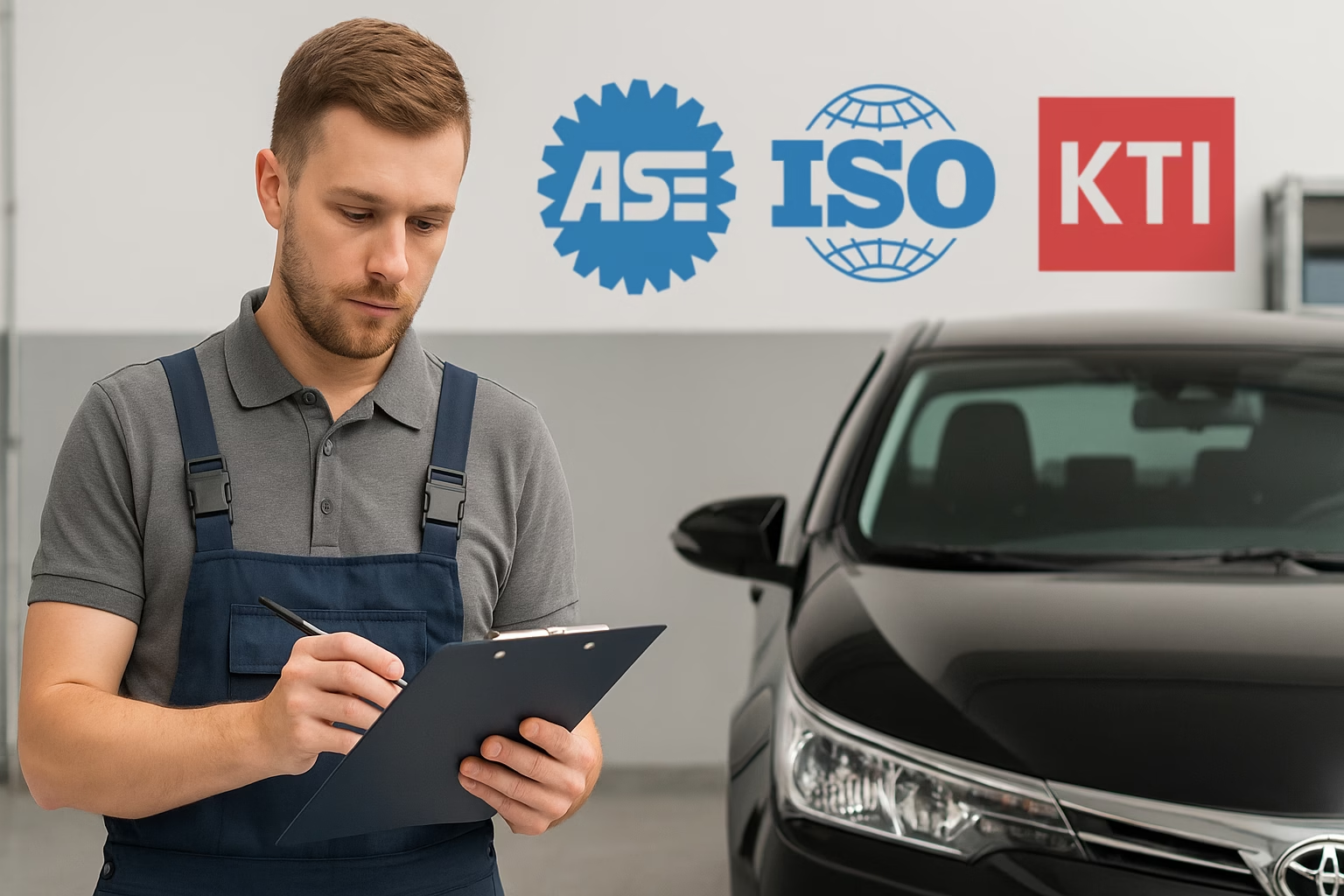Advanced driver assistance systems have transformed vehicle repairs into highly technical operations. Where windscreen replacements and bumper repairs once required little more than mechanical skills, calibrating cameras, radar and LiDAR now demands an understanding of optics, signal processing and software. As ADAS becomes more common and regulatory frameworks tighten, insurers and manufacturers expect workshops to prove that their technicians are properly trained and certified. The result is an emerging ecosystem of training programs and certification paths tailored to the growing ADAS calibration industry.
Factory training remains the cornerstone of ADAS competence. Most vehicle manufacturers offer dealer-level courses that cover the theory and practice of calibrating their specific systems. Toyota’s Safety Sense training, for example, teaches technicians how to recognise sensor types, interpret diagnostic trouble codes, use Toyota Techstream software and perform static camera calibrations with the correct targets. Honda provides its ‘Honda Sensing’ training at regional training centres, where students learn dynamic radar and camera calibration procedures and how to avoid common mistakes like misaligned targets or incorrect ride height. Tesla’s service technician program includes modules on Autopilot camera replacement and system validation, while Mercedes-Benz and BMW offer comprehensive ADAS courses through their dealer academies. These courses are usually restricted to authorised repairers and may require prerequisite mechanical or electrical qualifications, but they provide direct access to manufacturer documentatio
Independent training providers fill the gap for workshops that service multiple brands or who operate outside the dealer network. Organisations such as I-CAR (Inter-Industry Conference on Auto Collision Repair) offer ADAS calibration classes that cover multiple manufacturers and provide hands-on experience with popular calibration rigs. I-CAR’s courses, available in the United States, Australia and Canada, teach technicians how to set up static targets, perform dynamic calibrations and document results for insurers. Another well-known provider is Autel Academy, which trains technicians to use Autel’s calibration frames, scan tools and software; their curriculum covers sensor theory, target placement, OEM procedures and troubleshooting. Bosch, Hella Gutmann Solutions and Hunter Engineering also offer multi-day ADAS courses that combine classroom instruction with practical exercises on demonstration vehicles. In the UK, companies like Pro-Align and ABC ADAS run accredited courses recognised by the Institute of the Motor Industry (IMI).
Many of these courses lead to formal certification. In North America, the National Institute for Automotive Service Excellence (ASE) has incorporated ADAS topics into its A4 (suspension and steering), A5 (brakes) and A6 (electrical) tests and is developing an ADAS-specific credential. I-CAR’s ADAS technician role recognition requires completion of multiple ADAS courses and ongoing continuing education. In the UK, IMI offers Level 2 and Level 3 qualifications specifically for ADAS calibrations. Level 2 provides foundational knowledge of radar and camera systems, while Level 3 focuses on diagnostic strategies and calibration. European technicians can also pursue TÜV SÜD certificates or attend training at the Thatcham Research centre, which has established ADAS certification for body shops. In Australia, TAFE institutions and trade schools have started to integrate ADAS modules into automotive mechanical and collision repair courses, preparing technicians to handle calibrations across multiple brands.n
Tool manufacturers support their equipment with dedicated training. Companies like Hella Gutmann Solutions, Texa and Launch supply calibration frames, laser measuring devices and scan tools. Their training programs are designed to teach technicians how to assemble and align the hardware, connect the software and perform calibrations according to OEM specifications. Completing a manufacturer’s training often grants access to technical support lines and software updates. For example, attending a Hella Gutmann ADAS calibration course teaches proper use of their CSC-Tool frame and how to adapt it to different vehicle platforms. Autel’s training emphasises using digital target positioning and scan tool integration to streamline calibrations. Workshops investing in a new calibration rig should plan for this training as part of the purchase, because improper setup can result in failed calibrations and liability exposure.
The last few years have accelerated the adoption of online and blended learning. Many providers now offer e-learning modules that cover ADAS theory, sensor identification and diagnostic strategies. These modules allow technicians to study at their own pace and reduce travel costs. However, ADAS calibration is inherently hands-on, and most reputable courses include a practical component. Some organisations use a hybrid model, with theory delivered online followed by in-person assessments on vehicles. When evaluating online offerings, technicians should look for accreditation and ensure that the course includes live demonstrations, interactive elements and instructor support rather than just recorded videos. and support.
Choosing the right training and certification path depends on the workshop’s business model and the brands they service. Independent collision repairers who handle multiple makes may benefit from broad-spectrum programs like those offered by I-CAR, Autel or Bosch, backed by a recognised certificate. Dealer-affiliated technicians should prioritise OEM training, as procedures vary widely between manufacturers and some calibrations require proprietary scan tools. Workshops planning to invest in calibration equipment should coordinate with the manufacturer to schedule training and ensure staff are comfortable with the hardware. In all cases, it is important to verify that the program is accredited by a respected body (such as ASE, IMI or a national vocational authority) and that it covers both static and dynamic calibration methods.
Certification is more than a plaque on the wall. Insurers and fleet operators increasingly require proof that ADAS calibrations are performed by qualified technicians using approved equipment. Proper training reduces the risk of incomplete calibrations that could lead to accidents or liability claims. It also improves efficiency; a trained technician can complete calibrations more quickly and identify issues that might cause recalibration or sensor replacement. With ADAS technology evolving from camera and radar into LiDAR and vehicle-to-everything sensors, ongoing education is essential. Technicians should view certification as a starting point and commit to continual learning through refresher courses, technical bulletins and manufacturer updates.
Worldwide, the ADAS training landscape is expanding to meet demand. Whether through OEM academies, independent training providers or equipment manufacturers, technicians have multiple paths to gain the knowledge and credentials needed. By investing in the right training and staying current with emerging technologies, workshops can ensure they deliver safe, reliable ADAS calibrations and remain competitive in a changing industry.

Hiran Alwis is an automotive lecturer and ADAS specialist with over 15 years of experience in diagnostics, advanced safety systems, and technical training. He founded ADAS Project to help everyday drivers and workshop technicians understand and safely use advanced driver assistance systems.
